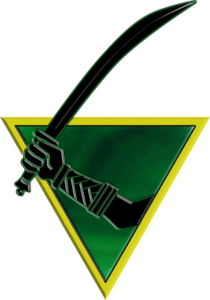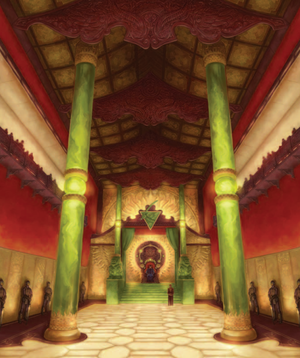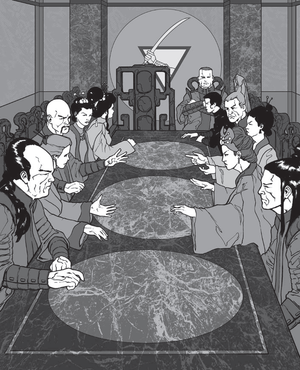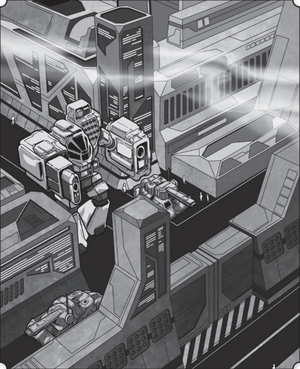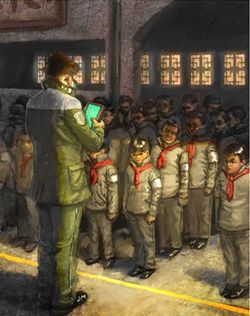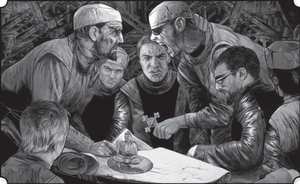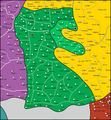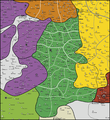Capellan Confederation
This article needs to be updated with material from Field Manual: 3085, Objectives: Capellan Confederation, First Succession War (sourcebook), Second Succession War (sourcebook), Shattered Fortress. Once these titles clear the Moratorium period, or if they already have, please consider revisiting this article and updating it with the new material. |
| Capellan Confederation | |
|---|---|
| State Profile | |
| Founding Year | July 2367[1] |
| Capital world: | Sian |
| Controlled system(s): | ca. 217 |
| Government | |
| Head of State | Chancellor |
| Civilian Intelligence | Maskirovka |
| Military | |
| Commander-in-chief | Strategic Military Director |
| Army | Capellan Confederation Armed Forces (CCAF) |
| Navy | Capellan Confederation Navy |
The Capellan Confederation is the smallest and youngest of the Successor States. A socialistic police state with strong Chinese and Russian influences, the Confederation is ruled by the authoritarian Chancellor, who has almost always been a member of House Liao. During the years of the Succession Wars the Capellan Confederation was the perpetual underdog, losing territory to its aggressive neighbors and verging on the brink of total collapse before regaining much of its strength by the middle of the thirty-first century. By the early to mid-thirty-second century, the Capellan Confederation had become one of the most powerful states in the Inner Sphere. Possessing a well-trained and motivated war machine that was the best-armed of the non-Clan states and which had the greatest offensive capability. Many Capellans take pride in their citizenship — not least because it must be earned — and view service to the State as a worthy sacrifice for the good of humanity. Originally founded on Capella, its current capital world is Sian.
Contents
History[edit]
After the end of the Hegemony-Supremacy War, the Capellan Commonality was formed in 2310 as a loose federation of all the major powers occupying the Capellan Zone.
In the midst of a Federated Suns "peacekeeping" operation, the heads of the major Capellan powers met on St. Andre in July 2367. There, Duke Franco Liao of the Duchy of Liao made a radical proposal: dissolve the Commonality and unify the entire Capellan Zone under a centralized authority strong enough to resist foreign intervention. After much debate, the motion was adopted, and the Capellan Confederation was born.[2]
The Capellan Confederation enjoyed great prosperity with the peace brought about by the Star League, but it was not to last. At the outbreak of the Star League Civil War, Chancellor Barbara Liao adopted a position of armed neutrality, allowing neither Aleksandr Kerensky's nor Stefan Amaris' forces to enter Capellan territory. With the dissolution of the Council, and the self-imposed exile of Kerensky and the Star League Defense Force, the Succession Wars became inevitable.[3]
The First Succession War began in December 2786, and the Confederation made large gains by occupying worlds of the former Terran Hegemony, most of which fell peacefully, and launching attacks against the Free Worlds League and Federated Suns. The First Succession War finally came to an end in 2821 with a ceasefire between the Liao and Davion realms.[4]
The start of the Second Succession War in 2828 was inauspicious as Ilsa Liao became the first Chancellor killed in combat, personally commanding the rearguard after the failed invasion of Orbisonia. A ceasefire was achieved in 2862 when Dainmar Liao agreed to humiliating concessions to the Federated Suns, but peace only lasted a few more years before the Third Succession War began.[5]
Towards the end of the Third Succession War, the Confederation turned towards subterfuge where force no longer worked: Chancellor Maximilian Liao helped to spark Anton's Revolt in the Free Worlds League, and began plotting with Michael Hasek-Davion to achieve the same within the Federated Suns. However, the Fourth Succession War helped cut that conspiracy off at the knees as the Confederation found itself the target of the newly christened Federated Commonwealth. The Capellan Confederation was nearly destroyed in the Fourth Succession War, and what worlds it didn't lose to the FedCom alliance broke away to form their own splinter states, the Tikonov Free Republic and St. Ives Compact.[6]
Though severely weakened, the Confederation survived the Andurien Crisis, which helped to improve morale within its military, and it was untouched by the Clan Invasion, giving the realm more time to rebuild itself. When it came time to deal with the Clan problem once and for all, Sun-Tzu was elected to become the First Lord of the Second Star League, a largely ceremonial position but one which brought further prestige to the state.[7]
Under the leadership of Sun-Tzu and then his son Daoshen Liao, the Capellan Confederation steadily grew in strength. It expanded its territories and reclaimed lost Capellan worlds. The Capellan Confederation came out of the Jihad in better condition than its rivals, with its military-industrial complex having suffered far fewer losses, proportionally. The Capellan armed forces had been rebuilt and turned into the Inner Sphere's best armed military force, one that was well trained and motivated. A force that was, offensively, the most powerful in the Inner Sphere. The Capellan Confederation is now one of the Inner Sphere's primary powers, and perhaps a threat to the Inner Sphere itself.[8][9][10]
Politics[edit]
The Capellan Confederation started out as a collection of states united for common defense and well-being, but over hundreds of years, through the influences of certain schools of philosophy and the leadership of House Liao, it has evolved to become an autocratic state with a controlled economy. While appearing to be nothing more than an absolute dictatorship to outsiders, the Confederation's government is closer to that of a troika, composed of three legislative bodies: the Chancellor, the Prefectorate, and the House of Scions. Each competes with the other for power, and even the strongest Chancellors have had to cooperate with the other two in order to pursue their policies.[11][12]
The Chancellor[edit]
The Chancellor is the face of the Capellan Confederation, invested with immense executive and legislative authority. The "Celestial Wisdom" is responsible for all domestic and foreign policy for the Confederation, and with the power to issue decrees can make legislative changes at will. The Chancellor serves as the commander-in-chief of the Capellan Confederation Armed Forces, and has personal control over the Warrior Houses and the Death Commandos. Although originally serving a ten-year term, the position was turned into a lifetime appointment by decree in 2480, and while not mandated by law the Chancellorship is essentially reserved for members of House Liao.[13][12]
The Prefectorate[edit]
Sometimes known as the Prefecture, the Prefectorate is the oldest and highest governing body in the Capellan state. Begun by Franco Liao as an advisory council, its members are elected from the House of Scions for ten-year terms. Originally numbering six individuals, each a representative from one of the six original commonalities, it was enlarged to twelve by Kurnath Liao to include other powerful men and women. Kurnath Liao also gave the Prefectorate certain legislative powers, although its most important function only came after the death of Duncan Liao, when the Prefectorate gained the right to designate one of its members as Chancellor.[11][14]
This right was diminished when the Chancellorship became a lifetime appointment, and severely curtailed when the Star League agreed to grant only members of House Liao a seat on the High Council, effectively limiting the Prefecture's choices. Additional restrictions came in 2598 when Chancellor Quinn issued the Decree of Succession stating that, in the event of failure to elect a new Chancellor after three formal votes, the Chancellorship would automatically go to the most senior member of House Liao. Only if a member of House Liao was unavailable or not of age could the Prefectorate choose another in their place.[11][14]
Despite its diminished purpose the Prefectorate still maintains significant powers. It is responsible for passing national tax legislation, appropriations for the armed forces, and officer appointments for those military units outside the Chancellor's direct control. The Prefectorate arbitrates disputes between commonalities and, at the Chancellor's discretion, may issue decrees and rule on court decisions. It also has the power to pass "acts of ennoblement", granting certain privileges and responsibilities to individuals within the Confederation, a power it has used as a way of counteracting decrees passed by the Chancellor. Finally, all legislation passed by the Prefectorate is inviolable (except by the House of Scions) and the body cannot be removed or disbanded by the Chancellor.[11][14]
House of Scions[edit]
The House of Scions is a governing body composed of Capellan nobility, originally formed as a check on the power of the Chancellor and Prefectorate. Membership is open to both types of nobility, although the twelve-year terms are staggered to ensure constant turnover. The power of the House of Scions has ebbed and flowed through the centuries, from superficial rubberstamp to serious political force. At first the House had the power to veto legislation passed by the Chancellor or the Prefectorate, but the right to review the Chancellor's decrees was removed by Mica Liao. During the Star League era the House gained the right to appoint new members to the Prefectorate, and after negotiations with Ilsa Liao it gained the right to determine taxes for individual commonalities, separate from the national taxes determined by the Prefecture. Like the Prefecture, any legislation passed by the House of Scions is also inviolable.[13][15]
| “ | In government, just as in economics and corporations, there is a trickle-down effect: decisions made at the top are passed to lower and lower levels of authority until finally they reach the people. The Chancellor must rule—he doesn't have time to speak individually to billions of Capellans on every decision. | ” |
| — Attributed to the President of the House of Scions, 2956[16] | ||
The Ministerial[edit]
The Ministerial is the bureaucracy responsible for enacting the legislature passed by the troika, created by Chancellor Baxter as a mea culpa for the incompetence of his administration. Each Ministry is headed by a director who reports quarterly to the Prefectorate, with a first and second deputy director under them and various department coordinators, assistants and administrative staff. Originally the Ministerial was divided between the commonalities in an attempt to prevent an unacceptable concentration of bureaucratic power. However, in 3059 Chancellor Sun-Tzu Liao ended this system and relocated all ministry headquarters to the Forbidden City on Sian.[17][18]
- Ministry of Resources (Sarna) - Responsible for coordinating all scientific research and the exploitation of all natural resources within the Confederation. During the Succession Wars, this mandate was expanded to include the recovery of all lostech. Also liaised with the Word of Blake during joint research projects.
- Ministry of Information Standards (Sian) - Coordinates weights and measures, including maintaining standard time and managing Capellan currency. Its mission has long been hampered by each polity within the Confederation maintaining their own separate timekeeping standards.
- Ministry of Trade and Exchange (Capella) - Responsible for overseeing trade relations with other realms. Additional duty of administrating the peoples and resources of recently liberated worlds.
- Ministry of Development (Chesterton at Sirius) - Oversees economic development and reconstruction within the Confederation, as well as the administration of vital agricultural worlds and general promotion of food production. Receives the largest share of the Capellan budget.
- Ministry of Social Education (St. Ives) - Maintains the state's education system and charged with indoctrinating the youth to become productive citizens. A focus of (private) criticism by many in the intelligentsia caste.
- Ministry of the Military (Tikonov) - Oversees all aspects of the armed forces, including financing, procurement, and sponsoring research. Serves as liaison for mercenary units.
- Ministry of Allied Relations - Created after the formation of the Trinity Alliance, specifically responsible for interstellar relations with the Magistracy of Canopus and Taurian Concordat.
Political Divisions[edit]
The highest administrative division within the Confederation is the Commonality, each ruled by a Duke or Duchess who also serves as its representative on the Prefectorate. In the beginning, each commonality was roughly analogous to the founding states of the Confederation: the Capella Commonality, Tikonov Commonality, Sian Commonality, Sarna Commonality and St. Ives Commonality (a sixth, the Chesterton Commonality, was created shortly thereafter but largely existed in name only, ruled in exile on Sian by the Hargreaves family).[17][19] That number was reduced to just two after the end of the Fourth Succession War, the Capella and Sian commonalities, while the Chesterton Commonality-in-Exile was abolished in 3040 when Chancellor Romano Liao banished the Hargreaves family. However, in the years after the Clan invasion, the Confederation was able to reclaim some of its lost territory, and by 3067 it had re-formed the Liao and St. Ives commonalities and created the Victoria Commonality.[19]
The commonalities are further divided into Duchies, each encompassing two to eight star systems, ruled by a duke or duchess. Each duchy is further divided into Warrens, usually a pair of star systems, and ruled by a ducal representative known as a Diem. Individual worlds within a warren are known as Demesnes and ruled by a nobleman under the authority of the local Diem, though the populace may appeal any decisions through their local Refrector. In each case, the noble in charge of each district has the power to rule over it as their own personal fiefdom — provided they obey all Capellan laws, of course. Additionally, unless a duchy or fiefdom is hereditary in nature, the Chancellor has the power to reassign each district at will.[17][18]
Citizenship[edit]
Unlike the other Successor States where individuals are born with citizenship, in the Confederation citizenship is a benefit to be earned. All minors in the Capellan Confederation are technically wards of the state under the provisional supervision of their parents or guardians. During this time, they receive a state sponsored education and are encouraged to participate in the betterment of their communities. By age 15, each Capellan child is evaluated to determine if they have proven their commitment to the state by participating in their community, whether through outreach work or civic participation. Those who are found to have provided service to the state are granted citizenship. Those who have not are given additional education and a grace period of two years after which they will have a second evaluation. Failure to earn citizenship after one's second evaluation relegates an individual to the class of noncitizens referred to as Servitors.[20][21]
Immigrants to the Confederation must also earn their citizenship, though it may occur a number of different ways. The simplest are for foreign nobles who can pay a "relocation fee" and immediately be inducted into the ranks of the Sheng nobility, albeit at one level lower than their previous rank. Other immigrants must undergo a full educational cycle on the meaning of Capellan citizenship and perform a service to the state, typically several months of unpaid labor within their chosen profession, before being accepted. For the populations of recently liberated worlds, all individuals are immediately made servitors and required to spend no less than five years in this condition until given the opportunity to earn their citizenship.[20][21]
Capellan citizens' rights are defined by the Capellan Concordat and their privileges many: membership in the caste system, free health care and education, retirement pensions, and more. While for the most part left to their own devices, citizens also have a number of obligations: they must take an oath of loyalty to the Confederation, to House Liao and the Chancellor; when so ordered they may be relocated to another world or retrained to serve in another industry (all at the state's expense); if not a member of the armed forces or Home Guard they must register with their local militia and serve during invasions or natural disasters. Above and beyond any legal obligations, citizens are expected to continue providing services to their community throughout their lifetime, and the state makes a point of continuing to promote and reward those who provide selfless service to the state. In contrast, the punishment for some of the most serious crimes (treason, cowardice, etc.) results in a loss of citizenship and automatic demotion to servitor status.[20][21]
| “ | Capellan citizenship is another avenue of personal liberty for those who earn it, though in an indirect way. Apart from the legal benefits enshrined in the Capellan Concordat, the process of earning the name of citizen reinforces a sense of individual worth along with the collective ideal. Making citizenship contingent on service to the state clearly emphasizes the state's paramount importance; citizenship is a privilege reserved for those who give something to the nation that nurtured them. At the same time, however, the newly minted citizen experiences a profound understanding of his or her personal value. His contribution alone won him the right to join the select company of the citizenry; he personally did something for his nation, which recognized and rewarded him by making him fully part of it.[22] | ” |
Military[edit]
The military of the Capellan Confederation is known as the Capellan Confederation Armed Forces (CCAF). Historically the CCAF has been a competent and professional military, equal to its enemies, but often hamstrung both by meddling Chancellors and trying to do too much with too little. The Chancellor serves as the commander in chief of the CCAF and has a seat on the Strategios, or Capellan Command Council, which in theory runs day-to-day operations of the military (though in practice this depends on the whims of the Chancellor). In a testament to House Liao's distrust of the military, the rank of General was abolished by Jasmine Liao (leaving their function in the hands of Senior Colonels) and would not be reinstated until six centuries later by Sun-Tzu Liao.
The CCAF is composed of both front-line and reserve units, as well as Home Guard and planetary militia units. Mercenary forces also play a major role in defending the Confederation, with McCarron's Armored Cavalry winning itself equal standing with the likes of other famous mercenary units. Outside the military chain of command and answerable only to the Chancellor are the elite Warrior Houses and Death Commandos.
Due to decades of fighting and changes brought about by Sun-Tzu Liao and his son Daoshen Liao, the CCAF are now a powerhouse in the Inner Sphere. Outside of the Clans, they are likely the best armed military force in the Inner Sphere. It is a battle-hardened war machine, one in which every unit is a flexible combined arms formation and whose tactical doctrine has been honed to a razor edge. Its men and women are well-trained and motivated.[23]
Economy[edit]

The Capellan economy is a centralized system based on the idea that sufficient planning can overcome any obstacle. Every four years, the Chancellor and the Ministry Planning Committee set economic goals and determine the level of productivity for each industry to meet these goals. Surprisingly, the economy has managed to flourish at times under this centralized direction, thanks in part to the density of the Capellan state, and the ability for Chancellors to quickly and unequivocally redirect economic production has helped it weather the many existential threats to the Confederation.[24][25]
Chancellor Normann Aris is most responsible for the socialistic nature of the Capellan economy. With the end of the Reunification War, revenues had dried up and the economy entered a deep recession. To combat the widespread hunger gripping his realm, Chancellor Aris enacted "compulsory organization" for all Capellan citizens. In exchange for the many rights and privileges given to them, Capellan citizens owed the state their service, and the state would be responsible for determining what that service entailed. This drastic change helped prevent the total collapse of the Capellan economy, though the citizens who engaged in strikes and shutdowns on hundreds of worlds across the Confederation didn't quite see it that way.[26][27]
Any hope that compulsory organization would be overturned after Aris' death were dashed when Sundermann Liao instead expanded upon the system. Sundermann made official the policy of relocating citizens to where they were most needed: if one planet had a shortage of teachers and another had too many, a sufficient number would be moved from one to the other until balanced was achieved. His son, Androsar Liao, helped patch up the societal riffs created by this policy by making it illegal to relocate a worker without also relocating their spouses and dependent children. This helped to keep families together and made the nobility wary of abusing the system due to the added expense. Androsar was also responsible for guaranteeing free education for all citizens which, among other benefits, allowed for training in a primary and secondary occupation, making the transition to a new job easier. During the golden years of the Star League Era, the Capellan economy enjoyed tremendous growth and a standard of living which would not be matched until centuries later.[26][28]
Centralized planning inherent in the Capellan economy proved fortuitous on occasion during the Succession Wars. The ability for the Chancellor to shift economic resources at will, for example, allowed for the creation and widespread distribution of new Vindicator 'Mechs by Chancellor Lisa Liao.[29] The drive towards centralization reached its apex under Chancellor Maximilian Liao, who reorganized the economy under the Liaoist Doctrine in 3005, tightening the Chancellor's grip on the economy at its expense.[25] As it lost territory to its enemies, the economy suffered alongside the state, culminating in the disastrous Fourth Succession War. As every industry was redirected to producing war matériel and all transports were dragooned into the military to carry troops and supplies, production of consumer goods simply stopped and famines broken out on a dozen worlds.[30] While the cessation of civilian good production was not intentional at first, Romano Liao made it official policy during her reign, setting aside only enough government funds for essential civilian services and legally outlawing nonmilitary manufactured goods in 3036. Romano took this effort a step further in 3040 by issuing a decree seizing all private property within the Confederation. Technically most of the property remained with their original owners in "caretaker" status, being forcibly taken away only when Romano suspected said owners of traitorous intentions.[31]
Such drastic measures arguably allowed the rump Confederation to survive the '30s and '40s, but by 3050 the policy was proving to be an existential threat to the economy, social unrest was spreading, and many nobles even entertained the possibility of openly disagreeing with the volatile Romano.[32] Her death paved the way for Sun-Tzu Liao to reverse his mother's decrees, allowing the resumption of civilian goods and returning any seized assets (provided the original owners were sufficiently loyal enough).[33] By the late 3050s, Sun-Tzu had shifted the economy towards a slightly more capitalistic outlook and opened it to more trade with the Free Worlds League, all while using careful economic and media manipulation to ensure greater demand for Capellan-made goods.[34] The Xin Sheng campaign also did much to revitalize the Capellan economy, while the creation of the Trinity Alliance gave the Confederation fertile markets in which it can expand.[25]
Manufacturing Centers[edit]
With one of the smallest Inner Sphere economies the Capellan Confederation, had the smallest industrial base, one that was further reduced as the other states chipped away at its territory. By the end of the Third Succession War, the Confederation had just eight surviving BattleMech production facilities, in various states of repair and efficiency, producing approximately 400 'Mechs per year.[35] This number was cut in half after the Fourth Succession War and the breakaway of St. Ives and Tikonov; it wouldn't be until 3036 that the surviving 'Mech factories on Sian, Betelgeuse, Ares, and Grand Base were repaired and operating at capacity.[36] While their loss was nearly a deathblow to the Capellan economy, those industries captured by the Davions continued to flourish under their rule, and with their reintegration in the latter part of the thirty-first century the Confederation was able to regain much of its lost strength.[37]
At the conclusion of the Jihad, of the major powers in the Inner Sphere, the Capellan Confederation's military-industrial capacity suffered the least. Which permitted the Capellans to quickly replace their battlefield losses, compared to the other states. Unlike the other states which reverted their industries to prewar production levels, House Liao secretly continued a buildup of BattleMechs, vehicles, and miscellaneous war matériel as their factories continued to run at wartime levels.[38][39]
3067[edit]
- Heavy Aerospace Industry[40]
- Major Defense Industries[41]
- Aldis Industries
- Bergan Industries
- Ceres Metals Industries
- Earthwerks Limited
- Hellespont Industrials
- Hellespont 'Mech Works
- HildCo Interplanetary
- Kressly Technologies
- Mujika Aerospace Technologies
- New Hessen WorkMechs
- Quikscell Company
- Saroyan Special Production
- Shengli Arms
- StarCorps Industries
- Tengo Aerospace
Culture & Society[edit]
For all its history of conflict and authoritarian regimes, life within the Capellan Confederation is relatively peaceful and comfortable for the average citizen. The needs of the state may supersede those of the individual, but most Capellans go through their daily lives without trouble, and in return the state provides for all of their basic necessities. The Capellan people are patient, hardworking and, above all else, proud: for having earned their citizenship rather than be given it; for knowing that their labors, whether in a mineshaft or a lab, is part of a larger purpose for the greater good; and in the rich cultural heritage bestowed upon them from the earliest days of the Capellan Republic.[20][21][42]
This pride has faltered through the centuries, in step with the faltering of the state as other realms chipped away at it, especially in the dark days after the Fourth Succession War. In the middle of the thirty-first century, as the state began to rebuild itself and again exert its authority, the Xin Sheng or "new birth" movement helped usher in a new wave of nationalistic fervor, affecting political, economic and military change throughout the realm, and a greater appreciation for the Han Chinese culture associated with House Liao. Unfortunately this campaign has also resulted in increased suspicion and racism towards those of non-Asian heritage, even fellow citizens.[21][42]
One trend found throughout Capellan society is veneration of the family, obedience to one's parents and respect for the elderly. There are no limits to the size of one's family — indeed it is seen as a service to the state to raise large families, and numerous incentives are available for those who do have many children. The first day of every month is considered a national family holiday with memorial services dedicated to honoring the sacrifices of one's ancestors in helping to build the Confederation.[43] As a further safeguard, it is illegal for the state to relocate a citizen without also relocating their entire family with them.[44]
The motto of the Confederation was "One Vision."[45]
Art & Entertainment[edit]
A thriving artistic community does exist within the Capellan Confederation, though it often finds itself subordinate to the will of the state. Technically, there are no limitations on freedom of expression. Given the low wages the Artisan caste earn though, most are dependent upon government grants for their survival, with the requisite "guidelines" steering their work towards more appropriate (some would say propagandist) forms of expression. The state also reserves the right to deny public exhibition of a work "in the interests of the people."[46][47] Painting, sculpting, music and theater are the most favored forms of artistic expression, while literature with its capacity for subversive thinking less so — in 3033, only sixty-seven works of fiction were allowed to be published — though under the Xin Sheng movement this trend has reversed itself. Numerous art fairs exist to display works by artists from both the Confederation and from around the Inner Sphere, such as the Native Capellan Art Fair and the Tikonov Universal Exhibition.[47][48]
The Capellan Broadcast Service is the official state-sponsored news and entertainment conglomerate for the entire Confederation, from the primary news hubs on Sian and each commonality capital world broadcasting via HPG down to the local community broadcasters. Compared to the profit-driven, fearmongering "free press" of other realms, CBS provides only informative news which reassures the populace that the state is looking out for their interests, a distinction for which many Capellans are publicly grateful. To ensure the news being broadcast is sufficiently pro-Capellan and not unduly disruptive to the peace and tranquility of society, each station has a political commissar on their staff (though not always identified as such), many of whom are secretly Maskirovka agents.[48]
Education[edit]
Education is completely free for every child from 5 to 16 years old and every citizen in the Capellan Confederation, though unlike other systems there is a strong emphasis on political indoctrination. State-sponsored elementary and secondary schools are located on every world and provide practically the same quality of education regardless of the planet's socioeconomic status.[49] However, should a planet's facilities prove inadequate, children will be temporarily relocated to another system at the state's expense.[50] In addition, the nobility are allowed to administer a separate educational system for their warren at their own expense. Most of these are dedicated to vocational and technical training and generally allow nobles to reward exceptional students with greater educational opportunities, though they must teach the same curriculum as state-sponsored schools and must allow admission for commoner students.[49][51]
After secondary education most citizens begin their mandatory militia training, though avenues for further educational pursuit exist. Military academies can be found in every commonality, each with its own martial focus, while admission is allowed only via appointment from a noble or Refrector. The Philotechnique Institutes are centers of postsecondary technical and scientific learning which were created in the middle of the twenty-eighth century. Students do not apply but are chosen by planetary directors with all expenses again paid by the state. Of the sixteen originally created, ten survived the Fourth Succession War, with a few recaptured after Operation Guerrero. Last is Sian University, with courses in nearly every field and students from across the Confederation and even foreign realms.[49][51]
Though education is available for all, historically there was prejudice against female students (excepting the children of nobles and MechWarriors), preventing them from achieving their full potential.[49] This changed starting in 3054 as Sun-Tzu Liao decreed gender equality for all students, using the Maskirovka as necessary to end this systemic discrimination. The result was an immediate increase in test scores, much of it attributable to female students.[51]
Religion & Philosophy[edit]
The Capellan Confederation, more than any other state in the Inner Sphere, has largely been indifferent to all forms of organized religion. A wide segment of the Confederation, especially the worlds near Terra, still practice organized religion, and legally all citizens are allowed freedom of worship, although local politics sometimes gets in the way of this liberty. Historically, the only times when House Liao involves itself in religious matters is when there is destabilizing conflict between different sects or a religious group is deemed to be too subversive. The latter can often result in swift and indiscriminate neutralization of the problem. In a break with tradition though, Chancellor Sun-Tzu Liao began to subtly promote Buddhism as part of his Xin Sheng movement, resulting in a sharp increase in Buddhist members as many Capellans align themselves with their leader.[52][53]
However, the state does involve itself in making sure the citizenry understand the "proper philosophical attitudes" by heavily promoting a trio of philosophical texts. The Korvin Doctrine, the oldest of the state-sponsored philosophies, argues that individuals must work together for the good of "the Greater Humanity" in order to ensure its survival among the stars. The Sarna Mandate, released around the same time as the Korvin Doctrine, argues that only those with the proper training — whether in military, scientific, or political matters — are competent enough to take a leadership role. Finally the Lorix Order, authored by CCAF Major Kalvar Lorix, exemplifies the MechWarrior as the supreme combatant (and by extension the Warrior Houses) whose greatest duty is loyalty to the citizenry they protect.[54][55]
To ensure the proper philosophical outlook is taught in primary and secondary schools, Philosophical Examiners will sit in on classes and review teachers' lesson plans. If a teacher's reliability is found wanting, they will be brought before a Court of Philosophical Inquiry (composed of three Examiners, a House of Scions member and a Prefect representative) and, if found guilty, can be given any punishment without appeal. For a time there also existed the Ranks of the Dedicated, a program instituted by Maximilian Liao using young adults to inform the government of any subversive elements in society, although it was eventually discontinued by Sun-Tzu's reign.[56][57]
Transportation[edit]
Travel within the Capellan Confederation is not completely restricted, though it is heavily monitored. Recreational travel is permitted for all citizens, though permanent relocation is allowed only if they have received permission from their Diem or have been so ordered by the Ministry of Development. Members of the Entitled caste are not under this restriction, nor are contracted mercenaries and active-duty military personnel (barring their military assignments). Any vessels attempting to cross the interstellar border will be subject to remote sensor scan and flight plan query, with physical inspection required as necessary. Interdiction is typically a Home Guard task, though depending on the system in question it could be front-line units or planetary militia instead; boarding parties along the border tend to be more rigorous than in the core, and include a more overt (or covert) Maskirovka presence. Following the creation of the Trinity Alliance, Canopian and Taurian ships were granted greater access into the interior of the Confederation, though this also opened to the door for more pirate and bandit raiding disguised as innocuous shipping.[58]
Era Specific Data[edit]
3145[edit]
- Fact Sheet: Capellan Confederation
- Founding Year: 2367[59][60]
- Capital (City, World): Zi-jin Cheng (Forbidden City), Sian
- National Symbol: A green arm raising a green dao sword, against a green triangle, edged in gold.
- Location (Terra relative): Rimward
- Total (Inhabited) Systems: 166
- Estimated Population (3130): 228,280,000,000
- Government: Dictatorship (Chinese feudal stylings)
- Ruler: Chancellor Daoshen (Centrella-) Liao
- Dominant Language(s): Chinese (Mandarin, official), Chinese (Cantonese), Russian, English, Hindi
- Dominant Religion(s): Buddhism, Taoism, Hinduism
- Unit of Currency: yuan (1 yuan = 0.56 C-bills/ 1.72 C-bills (3145)[61])
Era Maps Gallery[edit]
Capellan Confederation after the Reunification War in 2596
Historical: Maps[edit]
after Reunification War
Star League Era
after First Succession War
after Second Succession War
after Third Succession War
after Fourth Succession War
after War of 3039
before Clan Invasion
after Clan Invasion
after Operation Guerrero
during Second Star League
during Jihad
after Jihad
in 3081
creation of the Republic of the Sphere
before Gray Monday
in 3135
in 3145
See Also[edit]
References[edit]
- ↑ Handbook: House Liao, p. 13: "Timeline: Capellan Zone"
- ↑ Handbook: House Liao, pp. 13–16
- ↑ Handbook: House Liao, pp. 21–24
- ↑ Handbook: House Liao, pp. 26–30
- ↑ Handbook: House Liao, pp. 38–40
- ↑ Handbook: House Liao, p. 53
- ↑ Handbook: House Liao, p. 67
- ↑ Field Manual: 3085, p. 19
- ↑ Field Manual: 3085, p. 21
- ↑ Field Manual: 3145, p. 27
- ↑ 11.0 11.1 11.2 11.3 House Liao (The Capellan Confederation), p. 57
- ↑ 12.0 12.1 Handbook: House Liao, p. 90
- ↑ 13.0 13.1 House Liao (The Capellan Confederation), p. 58
- ↑ 14.0 14.1 14.2 Handbook: House Liao, p. 91
- ↑ Handbook: House Liao, p. 93
- ↑ Handbook: House Liao, p. 97: "Sub-National Governments"
- ↑ 17.0 17.1 17.2 House Liao (The Capellan Confederation), p. 58
- ↑ 18.0 18.1 Handbook: House Liao, p. 94
- ↑ 19.0 19.1 Handbook: House Liao, p. 97
- ↑ 20.0 20.1 20.2 20.3 House Liao (The Capellan Confederation), pp. 109–110
- ↑ 21.0 21.1 21.2 21.3 21.4 Handbook: House Liao, p. 114
- ↑ BattleCorps: INN Newscast (Solaris Broadcasting Co. section), news item published [23/06/3072]: "Spotlight: Capellan Citizenship"
- ↑ Field Manual: 3145, p. 27
- ↑ House Liao (The Capellan Confederation), pp. 115–116
- ↑ 25.0 25.1 25.2 Handbook: House Liao, p. 128
- ↑ 26.0 26.1 House Liao (The Capellan Confederation), p. 42
- ↑ Handbook: House Liao, p. 21
- ↑ Handbook: House Liao, p. 22
- ↑ House Liao (The Capellan Confederation), p. 47
- ↑ Handbook: House Liao, p. 45
- ↑ Handbook: House Liao, p. 48
- ↑ Handbook: House Liao, p. 51
- ↑ Handbook: House Liao, p. 52
- ↑ Handbook: House Liao, pp. 55–56
- ↑ House Liao (The Capellan Confederation), p. 107
- ↑ 20 Year Update, p. 60
- ↑ Handbook: House Liao, p. 130
- ↑ Field Manual: 3085, p. 21
- ↑ Field Manual: 3145, p. 27
- ↑ Strategic Operations, p. 15
- ↑ Tactical Operations
- ↑ 42.0 42.1 Inner Sphere, pp. 46, 48
- ↑ House Liao (The Capellan Confederation), p. 62
- ↑ Handbook: House Liao, p. 22
- ↑ BattleTech Primer, 2015 ed., p. 13: "House Liao (Capellan Confederation)"
- ↑ House Liao (The Capellan Confederation), p. 111
- ↑ 47.0 47.1 House Liao (The Capellan Confederation), p. 114
- ↑ 48.0 48.1 Handbook: House Liao, pp. 118–119
- ↑ 49.0 49.1 49.2 49.3 House Liao (The Capellan Confederation), p. 113
- ↑ House Liao (The Capellan Confederation), p. 112
- ↑ 51.0 51.1 51.2 Handbook: House Liao, pp. 116–119
- ↑ House Liao (The Capellan Confederation), p. 63
- ↑ Handbook: House Liao, p. 121
- ↑ House Liao (The Capellan Confederation), pp. 64–65
- ↑ Handbook: House Liao, pp. 122–123
- ↑ House Liao (The Capellan Confederation), p. 66
- ↑ Handbook: House Liao, p. 126
- ↑ Handbook: House Liao, pp. 155–156
- ↑ Handbook: House Liao, p. 13: "Timeline: Capellan Zone"
- ↑ Handbook: House Liao, pp. 15–16: "Caroline's Words"
- ↑ Era Report: 3145, p. 194: "Currency Conversion Table"
Bibliography[edit]
- 20 Year Update
- BattleCorps Solaris Broadcasting Co., 23/06/3072: "Spotlight: Capellan Citizenship"
- BattleTech Primer
- Binding Force
- Blood Legacy
- Bred for War
- By Temptations and By War
- Dagger Point
- Dawn of the Jihad
- Double-Blind
- Endgame
- Field Manual: Capellan Confederation
- Field Manual: Updates
- Fortress Republic (novel)
- Ghost War
- Grave Covenant
- Highlander Gambit
- House Liao (The Capellan Confederation)
- Jihad Hot Spots: 3070
- Jihad Hot Spots: 3072
- The Killing Fields
- Lethal Heritage
- Lost Destiny
- Prince of Havoc
- Principles of Desolation
- Strategic Operations
- Sword of Sedition
- Tactical Operations
- Threads of Ambition
- Warrior: Coupé (novel)
- Warrior: En Garde (novel)
- Warrior: Riposte (novel)



